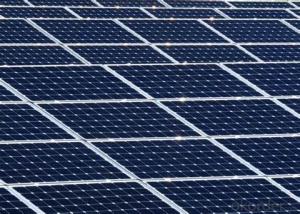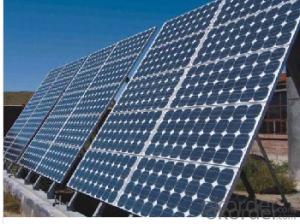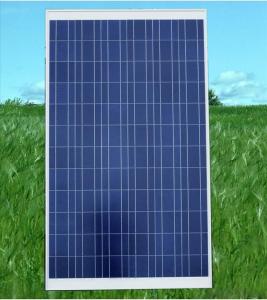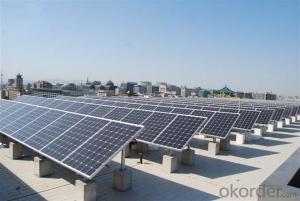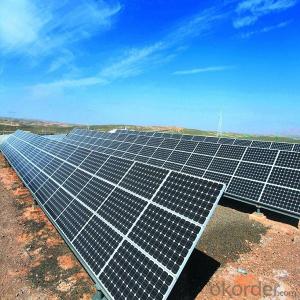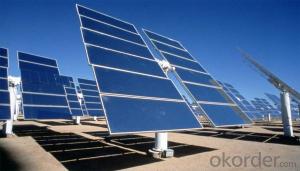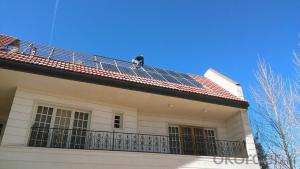Ohio Solar Panels - Polycrystalline Solar Panels 265W with High Efficiency
- Loading Port:
- China main port
- Payment Terms:
- TT OR LC
- Min Order Qty:
- 1000 watt
- Supply Capability:
- 1000000 watt/month
OKorder Service Pledge
OKorder Financial Service
You Might Also Like
Specification
Introduction of Poly solar panels CNBM
Polycrystalline Solar Panels 265W With High Efficiency
CNBM Solar photovoltaic (PV) Panel is designed for large electrical power requirements. It is the optimal choice for both on-grid and off-grid power systems. CNBM Solar panel offers high performance of power per square foot of solar array. Monocrystalline silicon(c-Si): often made using the Czochralski process. Single-crystal wafer cells tend to be expensive, and because they are cut from cylindrical ingots, do not completely cover a square solar cell module without a substantial waste of refined silicon. Hence most c-Si panels have uncovered gaps at the four corners of the cells.

Feature
1.Solar Cell : High efficiency crystalline solar cell. Even if under the weak light, the solar module can produce maximum power output.
2.Tempered glass (toughened glass): Anti-reflecting coating and high transmission rate glass increase the power output and mechanical strength of solar module.
3.EVA and TPT: Using high quality EVA and TPT to prevent destroying and water.
4.Long lifetime: ≥25 years; Less power decrease.
5.Resisting moisture and etching effectively, not effected by geology.
6.The certificate issued by international authority: UL, TUV, IEC, VDE, CE.
Specification
Characteristics of Poly solar panels CNBM | |||||
Max Power Voltage Vmp(V) | 30.3 | 30.8 | 31.1 | 31.4 | 31.85 |
Max Power Current Imp(A) | 7.60 | 7.64 | 7.73 | 7.81 | 7.85 |
Open Circuit Voltage Voc(V) | 36.1 | 36.6 | 37 | 37.3 | 37.68 |
Short Circuit Current Isc(A) | 8.50 | 8.55 | 8.65 | 8.75 | 8.85 |
Max Power Pm(W) | 230W | 235W | 240W | 245W | 250W |
Temperature Coefficient of Cells Poly solar panels CNBM | |
NOCT | 45℃ ± 2℃ |
Temperature Coeffucients of Isc (%/℃) | 0.0492 |
Temperature Coeffucients of Voc (%/℃) | -0.3374 |
Temperature Coeffucients of Voc (%/℃) | -0.4677 |
Mechanical Data of Poly solar panels CNBM | |
Dimension | 1638 × 982 × 40 mm |
Weight | 19.5 kg |
No. of Cells and Connections | 60 (6 ×10) |
Tolerance | 0 ~ + 5 W |
Cell | Monocrystalline Cell 156 × 156 mm |
Packing | 624 Pcs/40ft(H) Container |
Limits of Poly solar panels CNBM | |
Operating Temperature | -40℃ to +85℃ |
Storage Temperature | -40℃ to +85℃ |
Max System Voltage | 1000VDC(IEC) / 600VDC(UL) |
Guarantees of Poly solar panels CNBM | |
Products Guarantee | 12 yrs free from defects in materials and workmanship |
Performance Guarantee | No less than 90% within 10yrs and no less than 80% within 25yrs |
Certificates | TUV(IEC61215&IEC61730),VDE(IEC61215&IEC61730),UL,CE |
Packaging Information
Package:26pcs/box
Quantity:1 box/pallent
Loading Capacity:952pcs/40ft
- Q: Solar panels are costly.Do you know any inexpensive way?So that i can make one of my own.
- you could use a water container with the sun focased on it and make it so that the water that gets heated goes out of a tube near the middle and the tube would lead to a turbine that generates electricity when water is forced through the tube( like an IV machine pump they use in hospitols only reversed so that it generates power instead of using power) then lead the tube back to the very top to release the water. PS basic principle behind idea is that water moves when heated and slows when cooled HARNESS THAT ENERGY
- Q: Can solar panels be used in areas with high levels of air pollution?
- Yes, solar panels can still be used in areas with high levels of air pollution. While air pollution can reduce the efficiency of solar panels, they can still generate electricity even in polluted environments. However, regular cleaning and maintenance may be required to ensure optimal performance in such areas.
- Q: Are solar panels affected by temperature?
- Yes, solar panels can be affected by temperature. High temperatures can cause a decrease in their efficiency and overall power output. However, some modern solar panels are designed to handle higher temperatures more effectively, minimizing the impact on their performance.
- Q: Can solar panels be installed on a library or educational institution?
- Yes, solar panels can be installed on a library or educational institution. In fact, many libraries and educational institutions have already embraced solar energy and installed solar panels on their rooftops or surrounding areas. This helps them reduce their carbon footprint, save on electricity bills, and serve as a sustainable example for the community.
- Q: I am in the market for buying a home. There is one for salke that actually has solar panels on top. How are they used? Do you need to pay for gas and electric still. Does it really light up the house and keep it warm. WHat about the AC keeping hte house cool in the summer does it work for that too? Please explain in solar for dummy terms. I haveno clue about solar panels other thatn the fact that it needs sunlight to run.
- I think that rustoria67 bumped his head on some thing. There are thousands of homes using only solar panels to power their homes, and it no way near an acre of them. With the right setup Kw of panels will work. Remember one can't bring a boat to an airplane race and hope to win. Look at this link.
- Q: How do solar panels affect the property's community engagement?
- Solar panels can positively impact a property's community engagement by showcasing the owner's commitment to renewable energy and environmental sustainability. This can inspire and engage community members to consider renewable energy options themselves. Additionally, solar panels can serve as an educational tool, promoting awareness and understanding of the benefits of solar energy within the community.
- Q: Actually I want to convert my home electricity on Solar Panel to cut down electricity costI have 2 AC's, a refrigerator, 3 Television, 2 Computers, 4 Fans etc
- good okorder lots of good ideas there
- Q: Looking to install solar panels in my house.
- Wholesale prices for BP solar panels range between $335 for the 40 watts panel to $835 for the 70 watts panel. Here's a brief listing of wholesale prices for BP solar models: - BP340J solar panel (40 watts) @ $335 - BP350J solar panel (50 watts) @ $37 - BP375J solar panel (80 watts) @ $504 Right now I'm getting a series of 50 watt (7.5 volts) panels installed in my house. It's a start to reduce dependence on electricity bills and try get some tax rebates as well.
- Q: Are solar panels fire hazards?
- Solar panels are generally not considered fire hazards. While there have been some isolated incidents of fires related to solar panels, they are extremely rare and typically caused by faulty installations, damaged equipment, or external factors. When installed properly and maintained regularly, solar panels pose no significant fire risk.
- Q: I have in mind a small solar panel that could be plugged into a wall socket. Do I need a converter or some kind of interference between the two power sources so there aren't any unpleasant explosions? I don't know much about this sort of thing so please be nice.
- You're quite right that the solar panel can't be directly connected. I sense that you want to start small, but unfortunately, it's hard enough to make a system with a dozen or more panels pay back. (It can, we have a system...) But with just one panel, maybe a small one, the economy of scale is gone. You need to buy a grid-tie inverter, which watt-for-watt will be more expensive than a regular size one, and for a small panel, the $$/watt value will be poor. There are some [illegal in most places] tiny grid-tie inverters that I see advertised on the web from time to time, with an ordinary plug that goes into the wall. Those are generally against electrical codes, and the danger is real. There is also a crop of micro-inverters being sold by companies such as Enphase. These are legitimate products, but will still be costly per watt, and ultimately, it will be hard to have a net savings over time with just one panel. Have you already taken the conservation steps like LED light bulbs, efficient appliances (especially refrigerator), insulation, and using a power strip to turn off loads that are not being used? That stuff isn't sexy, but saves money fast.
Send your message to us
Ohio Solar Panels - Polycrystalline Solar Panels 265W with High Efficiency
- Loading Port:
- China main port
- Payment Terms:
- TT OR LC
- Min Order Qty:
- 1000 watt
- Supply Capability:
- 1000000 watt/month
OKorder Service Pledge
OKorder Financial Service
Similar products
Hot products
Hot Searches
Related keywords
